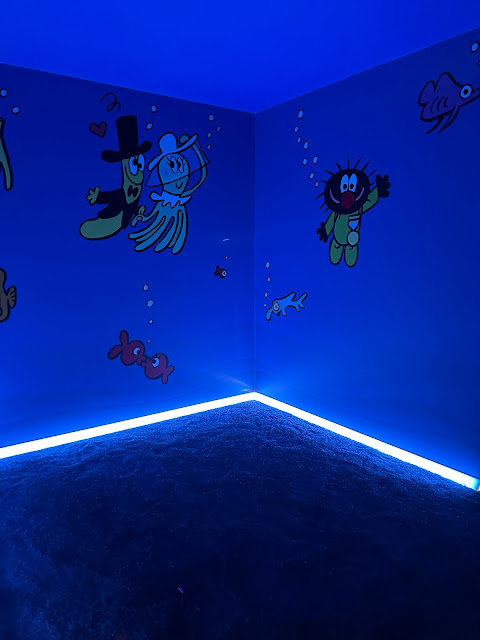Le Petit Poilu in concert: a fresh take on music and movement in comics
A “BD-Concert” at the Comics Art Museum in Brussels, Belgium. June 10, 2023
Reviewed by Laurie Anne Agnese
On a Saturday morning in June, in a small room just off the busy and bright majestic art nouveau hall of the Comics Art Museum in Brussels, three rows of small children were sitting on the steps in front of a stage with two musicians and a screen. Their parents, seated in chairs behind them, were coaxing them to be quiet and still. For some of these children as young as 2 or 3 years old, this was their first live concert; for nearly all, it was their first BD concert.
The BD concerts were programmed for the museum’s temporary exhibit of Le Petit Poilu (on display until August 15 2023), the popular wordless bande dessinée series that the Belgian cartoonist Pierre Bailly and scriptwriter Céline Fraipont created for preschool children. What is special about Le Petit Poilu is how children as young as 3 years old can read the pictures on their own and understand these complex stories independently of their parents.
The performance, the first of three scheduled that day, combined projected images from the comic to original live music. The concept leaned into the unique comic forms of Le Petit Poilu, while borrowing cinematic techniques to draw out the tensions and meaning of the story. Stéphane Arbon, wrote the score, and Christophe Bardon performed the live soundtrack mixing blues, rock and jazz to bring to life one of the older and better known stories in the series, Pagaille au Potager (Garden Frenzy). The two have been collaborating for more than twenty years, both as TOTOF et le grand orchestre intended for kids, and other collaborations.
In Pagaille au Potager, Petit Poilu starts his day like any ordinary preschooler - waking up and getting ready. But on his way to school, he falls down a mysterious hole and digs himself out into a lush, oversized garden where he has fantastical adventures with a group of friendly insects.
The good times are interrupted with the seemingly gratuitous aggression of a bee who attacks and stings Poilu’s red nose that balloons with pain. The group sets out to enact their own revenge on the Bee. But during the dramatic confrontation, Petit Poilu witnesses the Bee’s troubling situation, pauses and dares to react with kindness, offering the Bee a chance to be friends. This is a classic Poilu story, mixing fantasy together with real world empathy.
Pagaille au Potager was the first Le Petit Poilu series to be made into an episode of the animated series, transforming the twenty-eight page wordless album into a fast-paced seven minute cartoon. This version, with characters sometimes speaking in balderdash and other nonsensical sounds, is entertaining and quick to the point, but more defined and narrower than the comic.
The BD concert is a fresh interpretation of the story, and rich with the human touch of the expressive line drawings, well-developed plot lines, and the live percussion and stringed instruments. At forty minutes long, the concert significantly slowed down the story, particularly the pacing of the visuals, allowing the audience to linger on the panels for much longer than they would while silently reading. The overall effect still gives enough space for interpretation, and feels true to the comic’s original form. The slide show, for example, played with the concept of the page in comics, carefully timing the display of still images, one next to the other, eventually filling the entire screen.
In other vignettes, basic cinematic techniques such panning, zooming, or animation, brought gentle movement to the characters and textures to the story, and were meant to direct the eye to emphasize beauty of the illustrations or highlight the tensions in the story. The score, however, was the consistent cinematic throughline; the original songs punctuated with sound effects, is playful and resonant, and in itself a reference to the musicality of the original comic.
Because of its use of structure and repetition, Le Petit Poilu is not silent at all, but actually quite musical and rhythmic. Arbon and Bardon’s interpretation and musical performance had much to add to the emotional richness of the story.
All photos and video taken by Laurie Anne Agnese

















